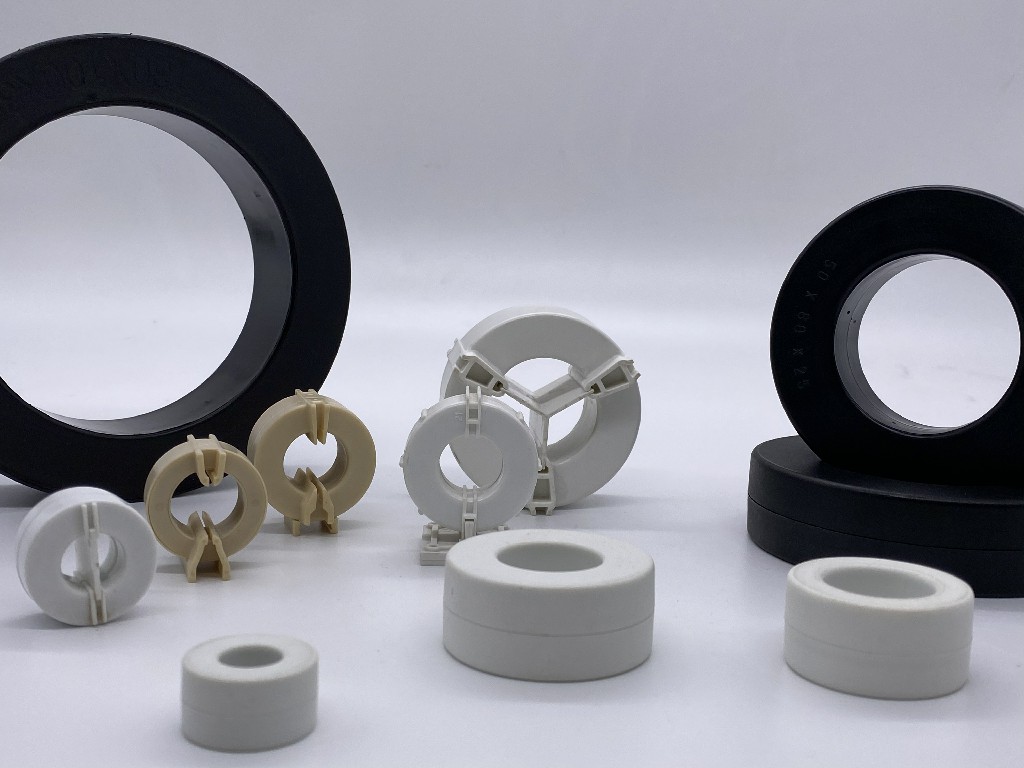Better Touch Better Business
Contact Sales at TRANSMART.
Amorphous magnetic core is a ferromagnetic iron core made of an amorphous alloy with ferromagnetism.In the past thousands of years, the metals or alloys used by human beings are all materials with crystalline structure, and their atoms are arranged in an orderly manner in a three-dimensional space to form a periodic lattice structure. Amorphous metal or alloy, also called metallic glass, refers to a material with an amorphous (also known as glassy) structure obtained by melting the metal or alloy through some form of non-equilibrium process, usually by melting The state is obtained by rapid quenching.Since the atoms of the metal or alloy are too late to be ordered and crystallized when they are solidified, the metal or alloy does not undergo crystallization processes such as nucleation and growth, but retains the condensed state of the disordered arrangement of liquid atoms at room temperature or low temperature, and its atoms no longer grow in order , Periodic and regular arrangement, but in a long-range disordered arrangement state, which gives amorphous materials many special properties.
Ferromagnetic properties are an important aspect of amorphous alloys that attract attention.Amorphous gold alloy with ferromagnetism is also called ferromagnetic metallic glass or glass (Glassy Alloy). It has high saturation magnetization, low coercivity, high permeability and large magnetostriction coefficient. For the convenience of description, the following are all referred to as amorphous alloys.The magnetic loss of amorphous alloys is lower than other known crystalline alloys. The resistivity of amorphous alloys is higher than that of similar crystalline alloys, and the temperature coefficient of resistivity is a small negative value, which can greatly reduce the eddy current loss of the material. The ultra-thin amorphous alloy strip has excellent high-frequency performance. At 1MHz, the loss of the 5.5μm-thick amorphous alloy core is 2/5 of that of the high-frequency ferrite, which is only 1% of the superpermalloy. 1/3.

For amorphous soft magnetic alloys, it can be divided into two categories: high saturation magnetic flux density and high permeability amorphous soft magnetic alloys according to the applied magnetic properties. According to its main components, it can be divided into: (1) Fe-based soft magnetic alloy with high saturation magnetic induction; (2) Fe-Ni-based amorphous alloy with medium saturation magnetic induction and good soft magnetic properties; (3) Cobalt-based alloy with excellent soft magnetic properties with saturation magnetostriction coefficient close to zero.
Iron-based amorphous iron core: It has high saturation magnetic induction (1.45T~1.56T) in almost all amorphous alloy iron cores, and at the same time has high permeability, low coercivity, low loss, low excitation current and good The temperature stability and aging stability. Mainly used to replace silicon steel sheet, as various forms and different power frequency distribution transformers, intermediate frequency transformers, operating frequency from 50Hz to 10KHz; as a high-power switching power supply reactor core, the operating frequency can reach 50KHz.
Fe-Ni-based amorphous iron core: medium to low saturation magnetic induction (0.75T), high magnetic permeability, low coercivity, wear resistance and corrosion resistance, and good stability. It is often used to replace the permalloy iron core as the zero-sequence current transformer iron core in the leakage switch.
Cobalt-based amorphous iron core: It has high magnetic permeability among all amorphous alloy iron cores, and at the same time has a medium to low saturation magnetic induction intensity (0.65T), low coercivity, low loss, and excellent wear resistance And corrosion resistance, good temperature stability and aging stability, resistance to shock and vibration. It is mainly used to replace permalloy iron core and ferrite iron core to make high-frequency transformers, filter inductors, magnetic amplifiers, pulse transformers, pulse compressors and other applications in high-end fields.
Copyright © 2025 TRANSMART INDUSTRIAL LIMITED | All Rights Reserved
Hello, please leave your name and email here before chat online so that we won't miss your message and contact you smoothly.